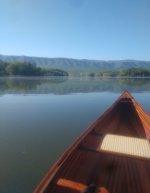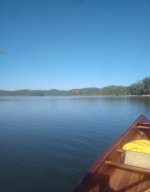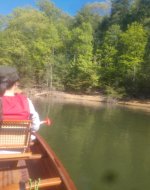My first thought is that the boy is paddling into the current upstream. I suspect that from looking at the vegetation and the water pile-up splash at his paddle blade. Paddling from the extreme bow is the best way for him, at his weight, to make upstream progress efficiently without the loss of muscular energy and forward vector velocity to yaw correction strokes.
First, his maximally forward center of gravity position renders makes it maximally likely that his bow won't yaw and that the canoe won't pivot downstream. By moving his weight as far forward as possible, he is maximally pinning the bow into the current to prevent yaw, just as shifting one's weight as far forward as possible would pin the bow into a strong wind if going upwind and preventing leecocking were the objective.
Second, the further he and hence the canoe's pivot point were to move aft in the canoe, the more likely the current would yaw the increasingly unweighted bow and tend to pivot the canoe, out of control, downstream. Sitting in the stern, as the ultimate contra example, would result in the least upstream vector control, because the canoe's pivot point would then be at the stern and the tendency of the bow to pivot downstream would be at its maximum.
Third, from the extreme bow, the boy can paddle up-current with the least possible time, force and energy wasted on stroke correction, since there will be virtually no forward stroke induced yaw to correct. Being right up in the prow, he can literally stroke along or very close to the keel line, which will impart almost no yaw (turning moment) to his forward strokes. No C, pitch, J, or loaded slice return will be needed to correct yaw, and hence all muscular energy will be focused on forward vector propulsion and none will be wasted correcting horizontal yaw.
Compare if he were sitting in the stern. Massive pivoting yaw would result from the down-sweeping current upon each forward stroke unless a huge amount of muscular energy were expended to implement equally massive yaw corrections, which would waste forward vector energy and forward velocity.
Finally, the boy is light enough, and the dugout is heavy enough, for him to sit up in the prow (stern seat backwards) without cantilevering the stern ridiculously high out of the water. If he were much heavier, the stern would become too airborne and the LWL would hence become too short for him to paddle as efficiently, because hull speed = 1.34 x √LWL. A heavier him would probably move further aft, possibly to bow seat forward, to maintain some fore-weighted bow pin while lowering the stern back into the water to increase LWL and forward hull speed.
If the boy were paddling downstream, he might change his position to further aft in the canoe, even at his light weight.
First, his maximally forward center of gravity position renders makes it maximally likely that his bow won't yaw and that the canoe won't pivot downstream. By moving his weight as far forward as possible, he is maximally pinning the bow into the current to prevent yaw, just as shifting one's weight as far forward as possible would pin the bow into a strong wind if going upwind and preventing leecocking were the objective.
Second, the further he and hence the canoe's pivot point were to move aft in the canoe, the more likely the current would yaw the increasingly unweighted bow and tend to pivot the canoe, out of control, downstream. Sitting in the stern, as the ultimate contra example, would result in the least upstream vector control, because the canoe's pivot point would then be at the stern and the tendency of the bow to pivot downstream would be at its maximum.
Third, from the extreme bow, the boy can paddle up-current with the least possible time, force and energy wasted on stroke correction, since there will be virtually no forward stroke induced yaw to correct. Being right up in the prow, he can literally stroke along or very close to the keel line, which will impart almost no yaw (turning moment) to his forward strokes. No C, pitch, J, or loaded slice return will be needed to correct yaw, and hence all muscular energy will be focused on forward vector propulsion and none will be wasted correcting horizontal yaw.
Compare if he were sitting in the stern. Massive pivoting yaw would result from the down-sweeping current upon each forward stroke unless a huge amount of muscular energy were expended to implement equally massive yaw corrections, which would waste forward vector energy and forward velocity.
Finally, the boy is light enough, and the dugout is heavy enough, for him to sit up in the prow (stern seat backwards) without cantilevering the stern ridiculously high out of the water. If he were much heavier, the stern would become too airborne and the LWL would hence become too short for him to paddle as efficiently, because hull speed = 1.34 x √LWL. A heavier him would probably move further aft, possibly to bow seat forward, to maintain some fore-weighted bow pin while lowering the stern back into the water to increase LWL and forward hull speed.
If the boy were paddling downstream, he might change his position to further aft in the canoe, even at his light weight.




